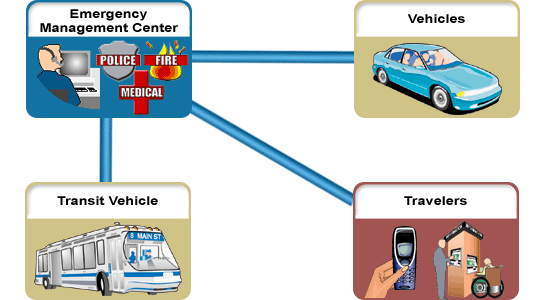Application Areas
Mayday
Description
This center-to-vehicle/traveler application area covers the interface that a driver or other traveler uses to summon assistance. It supports the capability for a driver or traveler to request emergency assistance through an electronic Mayday message, which could be manually initiated by the driver or traveler, or automatically initiated from within a vehicle or transit vehicle (e.g., following an accident). The traveler may be using a personal handheld device (e.g., personal data assistant), a traveler information device (e.g., a kiosk at a transit stop) or a panic button at a transit stop or facility. The application area includes the capability for the center to respond electronically to the emergency assistance request.
National ITS Architecture Interface
This application area includes the interface between four subsystems that can be used to generate an emergency notification or Mayday message and the Emergency Management Subsystem (EM) that receives the emergency notifications. When a traveler needs emergency assistance, an emergency notification is sent from the Vehicle Subsystem, Personal Information Access Subsystem (representing a personal portable device such as a PDA), the Remote Traveler Support Subsystem (representing a public device such as a kiosk) or the Transit Vehicle Subsystem (representing a panic button or silent alarm onboard the transit vehicle). The message received by the EM includes the source location, the time the message was sent, and available information about the originator and nature of the emergency. Typically, an acknowledgement is provided back to the traveler from the EM to confirm receipt of the emergency notification. The interface supports further communication of additional information required for emergency service providers to properly handle the emergency. The emergency request from the TRVS is issued to both the EM and the Transit Management Subsystem (TRMS).Applicable Standards
In general, the following standards are applicable to Mayday deployments. To determine which specific standards are applicable for a deployment you will need to determine which architecture flows will be needed for the Mayday piece of your deployment. Contact your local FHWA ITS Division Specialist or an ITS Standards Program Field Support Team contact
Deployment Resources
Deployment resources can be found in the deployment resources
section.